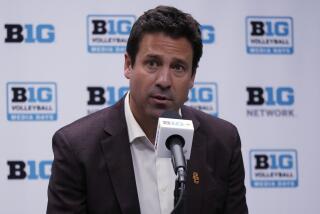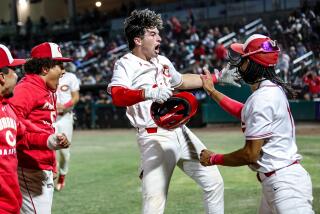Economy could force restrictions
UC Irvine’s baseball team leaves today for Hawaii, a season-opening trip that was scheduled several years ago.
That kind of long-distance travel, common for most top-tier programs, could be scaled back in the future as belt-tightening brought on by the economic downturn merges with a sport already coping with NCAA-mandated financial restrictions.
“Everyone is feeling it,” Irvine Coach Mike Gillespie said.
College baseball teams are allotted a maximum of 11.7 scholarships.
This season, for the first time, rosters will be capped at 35 players. A maximum of 30 can receive athletics aid. But also for the first time, any player receiving aid must be granted at least 25% of a full scholarship.
Next season, the maximum number of players who can receive aid drops to 27.
“It’s much more tricky than it has been, that’s for sure,” UCLA Coach John Savage said of balancing recruiting with scholarship restrictions.
Anticipating and paying travel costs also has become a challenge for a sport that lacks the revenue streams common in football and basketball.
With airlines now charging extra for a second bag, for example, college baseball teams are feeling the pinch.
“You’re talking about 35 players, so that starts adding up quick,” Pepperdine Coach Steve Rodriguez said.
However, Southland teams will still be on the move this season.
UCLA is traveling to Houston, Oklahoma and East Carolina. Cal State Fullerton will play at Southern Mississippi, Texas A&M; and in a tournament at Oklahoma State. USC travels to Tulane, and Pepperdine is heading to Wichita State.
Some coaches expressed concern that travel costs might give the NCAA added incentive for keeping West Coast teams close to home at tournament time, reducing the chances of more than one or two teams advancing to the College World Series.
Last season, Long Beach played host to a regional that included San Diego, California and eventual national champion Fresno State, which was seeded fourth.
“I don’t know how much worse you can make it look than our regional last year,” Long Beach Coach Mike Weathers said.
Regardless, economics are not expected to adversely affect the competitive level in the three conferences that include Southland teams.
The Pacific 10 Conference features four teams ranked in Baseball America magazine’s top 25. UCLA is 12th, Arizona State 13th, Stanford 15th and Oregon State 25th.
The Pac-10 is adding Oregon, which discontinued its program after the 1981 season. George Horton, who guided Fullerton to the 2004 national title and six College World Series appearances, has a team that features 14 junior college and five Division I transfers.
The Big West Conference includes two Southland teams ranked in Baseball America’s top 10. Fullerton, which lost to Stanford in a home super regional last season, is No. 5. UC Irvine, which lost in a super regional at Louisiana State, is No. 9.
Pepperdine, ranked 17th, is regarded as one of the favorites to win the West Coast Conference.
This season also marks the Division I debut of independent Cal State Bakersfield. Bill Kernen, who guided Cal State Northridge to the NCAA tournament in the 1990s before leaving to become a playwright, is at the helm.
--
--
latimes.com/sports
They’re up ahead
Cal State Fullerton and UC Irvine head the region’s college baseball teams in preseason rankings.
More to Read
Go beyond the scoreboard
Get the latest on L.A.'s teams in the daily Sports Report newsletter.
You may occasionally receive promotional content from the Los Angeles Times.







